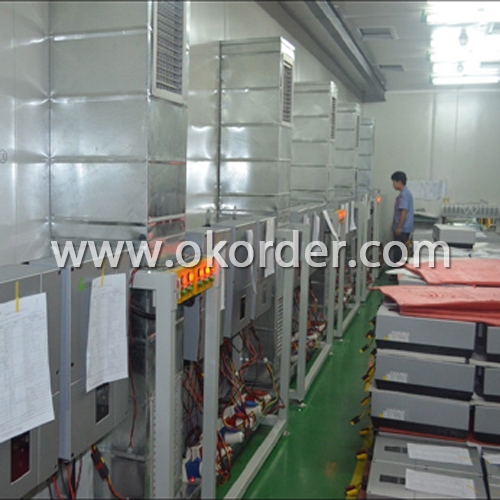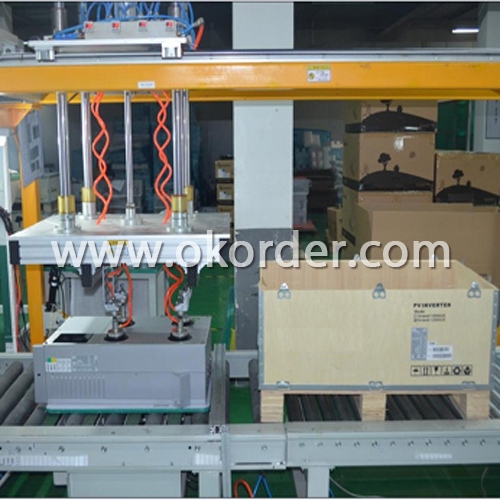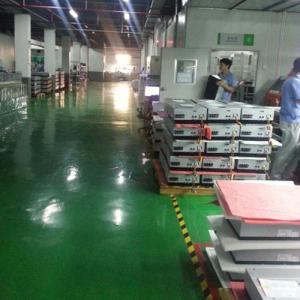Grid Tied Solar Inverter 3000W
- Loading Port:
- Shenzhen
- Payment Terms:
- TT
- Min Order Qty:
- 1 pc
- Supply Capability:
- 1-3000/month pc/month
OKorder Service Pledge
OKorder Financial Service
You Might Also Like
Short introduction of Grid Connected Solar Inverter 3000W
Maximum efficiency of 97.5% and wide input voltage range
Integrated DC switch-disconnected
MTL-String
Sound control
Bluetooth/RF technology /Wi-Fi
Transformerless GT topology
5 years warranty (10 years as optional)
Company introduction:
CNBM International Corporation (CNBM International) is the most important trading platform of CNBM Group Corporation, a state-owned company under the direct supervision of State-owned Assets Supervision and Administration Commission of the State Council.
With a R&D team more than 100 engineers,40% of the staff, who has been deeply engaged in the photovoltaic industry for 10 years, CNBM takes the mission to increase the inverter availability and efficiency, putting continuous innovation to make CNBM inverter easier for installation and operation, and more cost-effective for solar plant construction. The full range of CNBM single phase inverters has received VDE, CE, G83/1, G59/2, ENEL2010, VDE4105, C10/C11, AS4777 etc.
Maximum efficiency of 97.8% and wide input voltage range, Internal DCswitch,MTL-String, Sound control,Bluetooth/RF technology /Wi-FiTransformerless,GT topology
The Grid Connected Solar Inverter we can offer is 1.5kw to 20kw.
Datasheet of Grid Connected Solar Inverter 3000W
Model | CNBM-1500-US | CNBM-2000-US | CNBM-3000-US |
Input data |
| ||
Max. DC power | 1800W | 2300W | 3200W |
Max. DC voltage | 450V | 500V | 500V |
Start voltage | 150V | 150V | 150V |
PV voltage range | 100V-450V | 100V-500V | 100V-500V |
Number of MPP trackers/strings per MPP tracker | 1/1 | 1/2 | 1/2 |
Max. input current of the MPP tracker | 12A | 14A | 17A |
Output data |
| ||
Nominal AC output power | 1500W@208Vac 1650W@240&277Vac | 1800W@208Vac 2000W@240&277Vac | 2500W@208Vac 2800W@240&277Vac |
Max. output current | 8A/7.8A/6.8A | 9.7A/9.4A/8.2A | 15A/14.2A/12.3A |
AC nominal voltage; range | Default:240V single phase optional:208,240or277 single phase 183-228@208V 211-264V@240V 244-305@277V | ||
AC grid frequency; range | 60Hz;59.3-60.5Hz | 60Hz;59.3-60.5Hz | 60Hz;59.3-60.5Hz |
Phase shift (cosφ) | 1 | 1 | 1 |
THDI | <3% | <3% | <3% |
AC connection | Single phase | Single phase | Single phase |
Efficiency |
| ||
Max. efficiency | 97% | 97% | 97% |
CEC efficiency | 96% | 96.50% | 96.50% |
MPPT efficiency | 99.50% | 99.50% | 99.50% |
Protection devices |
| ||
Output overvoltage protection-varistor | yes | yes | yes |
Ground fault monitoring | yes | yes | yes |
Grid monitoring | yes | yes | yes |
General Data |
| ||
Dimensions (W / H / D) in mm | 360/465/165 | 360/465/165 | 360/465/165 |
Weight | 14.6KG | 15.1KG | 15.9KG |
Operating temperature range | -25...+60°C | -25...+60°C | -25...+60°C |
Altitude | Up to 2000m(6560ft) without power derating | ||
Consumption: operating(standby) / night | <5W / < 0.5 W | <5W / < 0.5 W | <5 W / < 0.5 W |
Topology | Transformerless | ||
Cooling concept | Natural | Natural | Natural |
Enclosure | Type 3R | Type 3R | Type 3R |
Features |
| ||
DC connection: | Screw terminal | Screw terminal | Screw terminal |
AC connection: | Screw terminal | Screw terminal | Screw terminal |
display | LCD | LCD | LCD |
Interfaces: RS485/RS232/Bluetooth/RF/Zigbee | yes/yes/opt/opt/opt | ||
Warranty: 5 years/ 10 years / 15 years | yes /opt | yes /opt | yes /opt |
Certificates and approvals | UL1741,UL1998 IEEE 1547, CSA C22.2 No.107.1-1,FCC Part15(Class A&B) | ||
Picture 1 Factory of Grid Connected Solar Inverter 3000W

Picture 2 Package of Grid Connected Solar Inverter 3000W

- Q:Can a solar inverter be used in remote locations?
- Yes, a solar inverter can be used in remote locations. Solar inverters are designed to convert the DC power generated by solar panels into AC power that can be used to power electrical devices. They can be used in off-grid or remote locations where access to a traditional power grid is not available.
- Q:What is the role of a solar inverter in a grid-tied system?
- The role of a solar inverter in a grid-tied system is to convert the direct current (DC) electricity produced by the solar panels into alternating current (AC) electricity that can be used by the electrical grid or consumed by the appliances and devices in a home or business. It also ensures that the solar energy generated is synchronized with the grid's voltage and frequency to enable efficient and safe transfer of power. Additionally, the solar inverter monitors and controls the flow of electricity between the solar panels, the grid, and any energy storage systems that may be connected to the system.
- Q:How does a solar inverter handle shading or partial panel obstructions?
- A solar inverter handles shading or partial panel obstructions by employing a technique known as Maximum Power Point Tracking (MPPT). MPPT enables the inverter to optimize the output power of the solar panels by constantly adjusting the operating voltage and current. When shading or obstruction occurs, the inverter automatically detects the affected panels and adjusts their output to minimize the impact on the overall system performance. This ensures that the system continues to generate as much power as possible, even in shaded conditions.
- Q:What is the efficiency loss of a solar inverter over time?
- The efficiency loss of a solar inverter over time is typically minimal, with modern inverters designed to maintain high conversion efficiency throughout their lifespan. However, some gradual degradation may occur due to factors such as aging components or environmental factors, resulting in a slight decrease in efficiency over the years. Regular maintenance and monitoring can help mitigate potential efficiency losses and ensure optimal performance.
- Q:How does a solar inverter affect the overall energy consumption of a property?
- A solar inverter converts the direct current (DC) generated by solar panels into alternating current (AC) that can be used to power electrical appliances in a property. By efficiently converting DC to AC, a solar inverter enables the property to utilize the renewable energy generated by the solar panels. This reduces the reliance on grid electricity, thereby decreasing the overall energy consumption of the property and leading to potential cost savings on electricity bills.
- Q:What is the role of galvanic isolation in a solar inverter?
- The role of galvanic isolation in a solar inverter is to provide electrical safety and prevent potential hazards. It separates the input and output circuits electrically, using transformers or optocouplers, to eliminate any potential voltage differences, ground loops, or electrical noise that could cause damage to the inverter or connected devices. Additionally, galvanic isolation helps to protect against electric shocks and ensures the safety of both the system and individuals working with or around the solar inverter.
- Q:Can a solar inverter be used with solar-powered signage systems?
- Yes, a solar inverter can be used with solar-powered signage systems. A solar inverter is responsible for converting the direct current (DC) produced by the solar panels into alternating current (AC) that can be used to power electrical devices. Since solar-powered signage systems also require AC power to operate, a solar inverter is necessary to ensure compatibility and efficient energy conversion.
- Q:Can a solar inverter be used in systems with different module efficiencies?
- Yes, a solar inverter can be used in systems with different module efficiencies. Solar inverters are designed to convert the DC power generated by solar modules into AC power that can be used in the electrical grid or for consumption. They are generally compatible with a wide range of module efficiencies and can efficiently handle different power outputs from the solar panels. However, it is important to ensure that the inverter's power rating matches the system's total power output to ensure optimal performance and efficiency.
- Q:Can a solar inverter be used with different types of grounding materials?
- Indeed, various grounding materials can be employed in conjunction with a solar inverter. Nevertheless, it is crucial to verify that the grounding system aligns with the manufacturer's prescribed specifications and guidelines for the specific solar inverter. The selected grounding materials must adhere to the essential safety standards and furnish adequate electrical grounding for the solar setup. It is advisable to seek guidance from a certified electrician or solar expert to ascertain the fitting grounding materials for your particular solar inverter and installation.
- Q:What are the advantages of using a solar inverter with battery storage?
- The advantages of using a solar inverter with battery storage include: 1. Energy independence: With a solar inverter and battery storage system, you can generate, store, and use your own electricity, reducing your reliance on the grid and ensuring a continuous power supply even during grid outages. 2. Increased self-consumption: The battery storage allows you to store excess solar energy generated during the day for use at night or during cloudy days, maximizing self-consumption and reducing the need to purchase electricity from the grid. 3. Time-of-use optimization: By storing excess solar energy and using it during peak demand periods, you can take advantage of time-of-use pricing, where electricity rates are higher during peak times. This can help you save money on your electricity bills. 4. Backup power: During power outages, the battery storage system can provide backup power, ensuring that critical appliances or equipment continue to function. This is particularly beneficial for homes or businesses that require uninterrupted power supply. 5. Environmental benefits: Solar energy is a clean and renewable source of energy. By using a solar inverter with battery storage, you can reduce your carbon footprint and contribute to a greener future by minimizing reliance on fossil fuels. 6. Grid support and stability: Battery storage systems can also provide grid support services, such as frequency regulation and peak shaving. This helps to stabilize the grid and improve overall energy efficiency. Overall, using a solar inverter with battery storage offers numerous advantages, including energy independence, cost savings, environmental benefits, and improved reliability of power supply.
1. Manufacturer Overview |
|
|---|---|
| Location | Shenzhen,China |
| Year Established | 2010 |
| Annual Output Value | 50 million USD |
| Main Markets | Australia, Euro, America, China. |
| Company Certifications | CE, VDE-AR-N4105, FCC,ETL,CEC,CEI 0-21,G83,G59,SAA,CGC |
2. Manufacturer Certificates |
|
|---|---|
| a) Certification Name | |
| Range | |
| Reference | |
| Validity Period | |
3. Manufacturer Capability |
|
|---|---|
| a)Trade Capacity | |
| Nearest Port | Shenzhen, Guangzhou, Hongkong |
| Export Percentage | 60% |
| No.of Employees in Trade Department | 260 |
| Language Spoken: | English, Chinese |
| b)Factory Information | |
| Factory Size: | 500-1000 |
| No. of Production Lines | 8 |
| Contract Manufacturing | None |
| Product Price Range | 300-40000 USD |
Send your message to us
Grid Tied Solar Inverter 3000W
- Loading Port:
- Shenzhen
- Payment Terms:
- TT
- Min Order Qty:
- 1 pc
- Supply Capability:
- 1-3000/month pc/month
OKorder Service Pledge
OKorder Financial Service
Similar products
New products
Hot products
Hot Searches
Related keywords




























